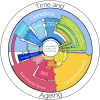Review: modulation of the oral microbiome by the host to promote ecological balance
- PMID: 30719639
- PMCID: PMC6732124
- DOI: 10.1007/s10266-019-00413-x
Review: modulation of the oral microbiome by the host to promote ecological balance
Abstract
The indivisible relationship between the human host and its oral microbiome has been shaped throughout the millennia, by facing various changes that have forced the adaptation of oral microorganisms to new environmental conditions. In this constant crosstalk between the human host and its microbiome, a bidirectional relationship has been established. The microorganisms provide the host with functions it cannot perform on its own and at the same time the host provides its microbes with a suitable environment for their growth and development. These host factors can positively affect the microbiome, promoting diversity and balance between different species, resulting in a state of symbiosis and absence of pathology. In contrast, other host factors can negatively influence the composition of the oral microbiome and drive the interaction towards a dysbiotic state, where the balance tilts towards a harmful relationship between the host and its microbiome. The aim of this review is to describe the role host factors play in cultivating and maintaining a healthy oral ecology and discuss mechanisms that can prevent its drift towards dysbiosis.
Keywords: Host factors; Modulation; Oral health; Oral microbiome; Symbiosis.
Conflict of interest statement
The authors declare that they have no conflict of interest.
Figures

References
-
- Gordon J, Knowlton N, Relman D, Rohwer F, Youle M. Superorganisms and holobionts. Microbe Mag. 2013;8(4):152–153.
Publication types
MeSH terms
LinkOut - more resources
Full Text Sources

